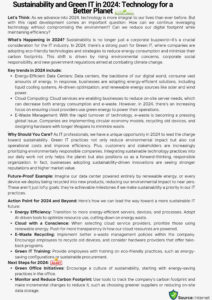
Introduction:
In an era characterized by rapid technological advancement, the world is on the cusp of a new technological revolution. From artificial intelligence (AI) and blockchain to quantum computing and augmented reality (AR), the pace of innovation is accelerating at an unprecedented rate. As we navigate the complexities of the digital age, it’s crucial to understand the emerging trends and innovations that are poised to reshape industries, redefine business models, and revolutionize the way we live and work.
- Artificial Intelligence (AI) and Machine Learning (ML):
Artificial intelligence and machine learning have emerged as game-changers across various domains, from healthcare and finance to retail and manufacturing. At its core, AI aims to simulate human intelligence processes through machines, enabling them to learn from data, adapt to new inputs, and perform tasks autonomously. Machine learning, a subset of AI, focuses on the development of algorithms that can learn from and make predictions or decisions based on data.
In 2024, AI and ML are expected to continue their trajectory of growth and innovation. With advancements in deep learning algorithms, neural networks, and natural language processing (NLP), AI-powered systems are becoming increasingly sophisticated and capable of performing complex tasks previously thought to be exclusive to humans. In healthcare, AI is being leveraged for disease diagnosis, drug discovery, and personalized treatment plans. In finance, AI-driven algorithms are revolutionizing trading strategies, risk management, and fraud detection.
Moreover, AI-powered virtual assistants and chatbots are transforming customer service experiences, providing personalized recommendations, and streamlining business operations. As AI technologies mature and become more accessible, organizations of all sizes can leverage these tools to drive efficiency, improve decision-making, and unlock new opportunities for growth and innovation.
- Blockchain Technology:
Originally conceived as the underlying technology behind Bitcoin, blockchain has evolved into a disruptive force with far-reaching implications across industries. At its core, blockchain is a decentralized, distributed ledger that records transactions securely and transparently. By eliminating the need for intermediaries and central authorities, blockchain technology offers unparalleled levels of security, efficiency, and trust in data exchange.
In 2024, blockchain technology is poised to revolutionize various sectors, including supply chain management, healthcare, finance, and digital identity. In supply chain management, blockchain enables end-to-end visibility and traceability of goods, reducing inefficiencies, mitigating counterfeiting, and ensuring compliance with regulatory standards. In healthcare, blockchain facilitates secure and interoperable sharing of patient data, enhancing care coordination, and enabling personalized treatment options.
Moreover, blockchain-based smart contracts automate and enforce agreements, reducing the need for intermediaries and streamlining business processes. With the emergence of decentralized finance (DeFi) platforms, blockchain is reshaping traditional banking and financial services, offering greater accessibility, transparency, and inclusivity. As blockchain protocols evolve to address scalability, interoperability, and sustainability challenges, we can expect continued innovation and adoption in the years to come.
- Quantum Computing:
Quantum computing represents a paradigm shift in computational power, harnessing the principles of quantum mechanics to perform calculations at speeds unimaginable to classical computers. Unlike classical bits, which can exist in one of two states (0 or 1), quantum bits or qubits can exist in multiple states simultaneously, enabling exponential parallelism and faster computation of complex problems.
In 2024, quantum computing is still in its nascent stages, with researchers and industry players racing to overcome technical hurdles and scale up quantum systems. Despite the challenges, quantum computing holds immense promise for tackling some of the most pressing challenges in science, engineering, and cryptography. In drug discovery, quantum computing can simulate molecular interactions with unprecedented accuracy, accelerating the development of new therapeutics and treatments.
In cryptography, quantum-resistant algorithms are being developed to protect sensitive information from quantum threats, such as Shor’s algorithm, which can factor large numbers efficiently. Moreover, quantum computing has the potential to revolutionize optimization problems, logistics, and materials science, unlocking new frontiers in innovation and discovery. As quantum hardware matures and becomes more accessible, we can expect quantum computing to usher in a new era of innovation and discovery.
- Augmented Reality (AR) and Virtual Reality (VR):
Augmented reality and virtual reality technologies are blurring the boundaries between the physical and digital worlds, offering immersive and interactive experiences across various domains. Augmented reality overlays digital content onto the real world, enhancing perception and interaction, while virtual reality creates entirely simulated environments, enabling users to explore and interact with virtual worlds.
In 2024, AR and VR technologies are poised to revolutionize industries ranging from gaming and entertainment to education and healthcare. With the advent of wearable devices, such as AR glasses and VR headsets, users can experience enriched environments and personalized content like never before. In gaming and entertainment, AR and VR offer immersive storytelling experiences, interactive gameplay, and new avenues for creative expression.
Moreover, AR and VR have applications beyond entertainment, including training and simulation, architectural visualization, and remote collaboration. In healthcare, AR and VR technologies are being used for surgical planning, medical education, and pain management. As AR and VR hardware becomes more affordable and accessible, we can expect widespread adoption and integration into everyday life, driving demand for innovative AR/VR applications and experiences.
- 5G and Internet of Things (IoT):
The rollout of 5G networks and the proliferation of Internet of Things (IoT) devices are ushering in a new era of connectivity, enabling seamless communication and data exchange on a global scale. 5G networks offer ultra-low latency, high bandwidth, and massive connectivity, unlocking new possibilities for IoT applications and services. IoT devices, ranging from smart appliances and wearables to industrial sensors and autonomous vehicles, generate vast amounts of data that can be leveraged to drive insights and innovation.
In 2024, 5G and IoT technologies are poised to transform industries ranging from transportation and logistics to healthcare and agriculture. With 5G’s high-speed connectivity and low latency, autonomous vehicles can communicate with each other and with infrastructure in real-time, improving safety and efficiency on the roads. In healthcare, IoT devices enable remote patient monitoring, telemedicine, and predictive analytics, improving patient outcomes and reducing healthcare costs.
Moreover, IoT sensors and actuators are revolutionizing agriculture, enabling precision farming techniques, optimizing resource utilization, and enhancing crop yields. As 5G infrastructure matures and IoT adoption accelerates, we can expect a proliferation of IoT-enabled services and solutions, driving efficiency, productivity, and innovation across industries.
Conclusion:
In conclusion, the future of technology is brimming with possibilities, fueled by innovation, collaboration, and a relentless pursuit of excellence. From artificial intelligence and blockchain to quantum computing and augmented reality, the technological landscape is undergoing a profound transformation, shaping the way we live, work, and interact with the world around us.
By staying informed and embracing these emerging trends, businesses and individuals can harness the power of technology to drive sustainable growth, foster innovation, and create a brighter future for generations to come. As we navigate the complexities of the digital age, let us seize the opportunities that lie ahead and embark on a journey of discovery, creativity, and progress. The future is ours to shape, and with the right tools and mindset, we can build a world where technology serves as a force for good, enriching lives and empowering communities across the globe.






